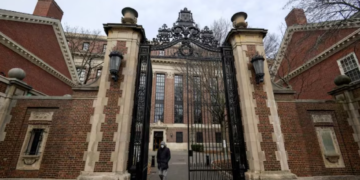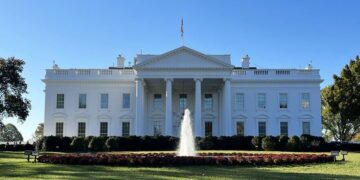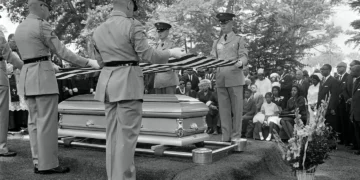Workers excavate a possible unmarked mass grave from the 1921 Tulsa Race Massacre at Oaklawn Cemetery in Tulsa, July 2020. Photograph: Sue Ogrocki/AP
July 15, 2024 Story by: Editor
A World War I veteran has become the first individual identified from graves containing over a hundred victims of the 1921 Tulsa Race Massacre, which devastated the city’s Black community, Tulsa’s mayor announced on Friday. This revelation emerged after the discovery of a nearly century-old letter in the National Archives.
Intermountain Forensics identified the remains as those of C.L. Daniel from Georgia, using DNA from his brothers’ descendants, said Mayor G.T. Bynum and lab officials. Daniel was in his 20s when he was killed.
“This is one family who gets to give a member of their family that they lost a proper burial, after not knowing where they were for over a century,” Bynum stated.
In 1921, a white mob massacred up to 300 Black individuals over two days, destroying a prosperous community known as Black Wall Street and forcing thousands of Black residents into internment camps under the National Guard.
Brenda Nails-Alford, a descendant of massacre survivors and a committee member overseeing the search for victims, expressed her emotions upon the identification.
“This is an awesome day, a day that has taken forever to come to fruition,” Nails-Alford said.
Searches since 2020 have uncovered more than 120 graves, with forensic analysis and DNA collected from about 30 sets of remains. Daniel’s remains are the first from these graves to be directly linked to the massacre.
The breakthrough in identifying Daniel came from a 1936 letter written by his mother’s attorney seeking veteran’s benefits. The letter noted the challenge in proving his death, stating he was “killed in a race riot in Tulsa Oklahoma in 1921,” reported CBS affiliate KOTV. Alison Wilde, a forensic scientist with Intermountain Forensics, said the letter convinced investigators of Daniel’s fate in the massacre.
“It’s her efforts, her perseverance, that led to the documentation that was able to give us the answers that we were searching for,” Wilde told the station.
“It’s shocking news,” Wilde remarked. No family members, many of whom are unfamiliar with each other, attended the news conference announcing the identification made earlier this week.
“I think it’s shocking news, to say the least,” Wilde said. “We know we’ve brought a lot into their lives.”
Daniel had no known connections to Tulsa and was last known to be in Utah, possibly passing through in June 1921, KOTV reported.
The massacre began with a white mob, including some deputized by authorities, looting and burning Tulsa’s Greenwood District. Over 1,200 homes, businesses, schools, and churches were destroyed from May 31 to June 1.
Forensic anthropologist Phoebe Stubblefield noted that Daniel’s remains were fragmented, making it impossible to determine the cause of death.
“We didn’t see any sign of gunshot wounds, but if the bullet doesn’t hit bone or isn’t retained within the body, how would we detect it?” Stubblefield explained.
Oklahoma state archaeologist Kary Stackelbeck stated that the remains, including Daniel’s, were found in simple wooden boxes, with Daniel’s casket being too small for him.
“They had to bend his legs somewhat at the knee in order to get him to fit,” Stackelbeck said. “His head and his feet both touched either end of the casket.”
Stackelbeck mentioned that investigators searched for simple caskets because they were described in historical newspaper articles, death certificates, and funeral home records as the type used for massacre victims’ burials.
Bynum announced that the next search for victims will commence on July 22.
“Identifying Mr. Daniel’s remains has been, candidly, an emotionally powerful experience for every person on our team,” Bynum said. “It makes every challenging day of this search worth it.”
The Oklahoma Supreme Court dismissed a lawsuit in June by the two known living survivors of the massacre. Attorneys for Viola Fletcher, 110, and Lessie Benningfield Randle, 109, are asking the court to reconsider the decision and are also urging the U.S. Department of Justice to investigate the massacre under the Emmett Till Unsolved Civil Rights Crime Act of 2007, which allows reopening cold cases of violent crimes against Black individuals committed before 1970.
Last year, Hughes Van Ellis, one of the last remaining massacre survivors, died at age 102.
Historian Hannibal B. Johnson, who has spent 30 years researching the Tulsa Massacre, told CBS News earlier this year there was a systemic erasure and minimization of the event’s significance.
“Tulsa was on an upward trajectory to becoming the oil capital of the world,” Johnson said. “We also know that conservatively estimated, the dollar damage from the destruction was roughly $1.5 to 2 million, which is equivalent to tens of millions of dollars today.” Source: CBS News

















